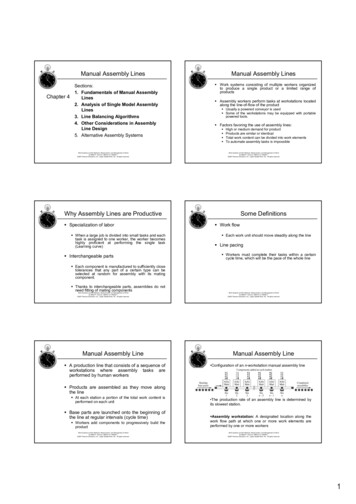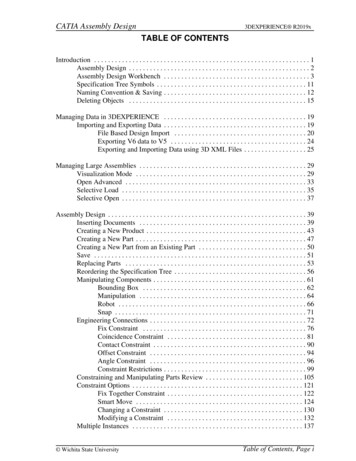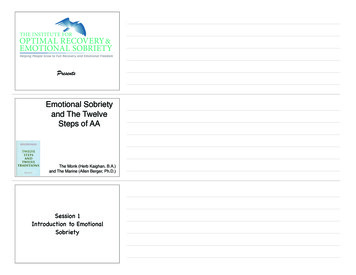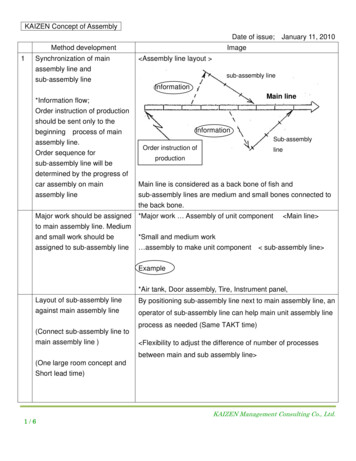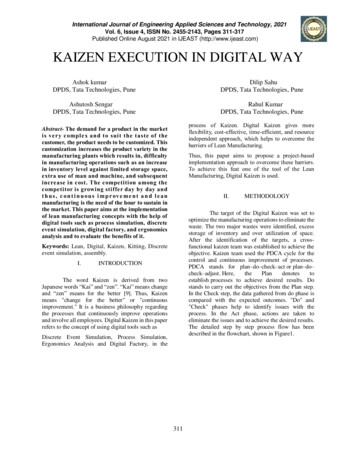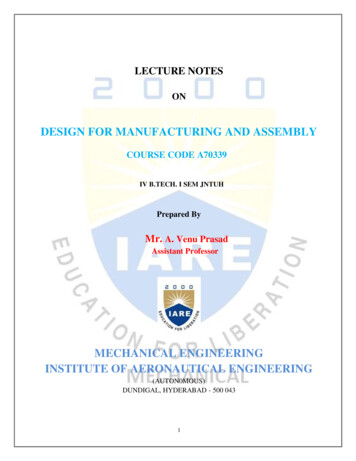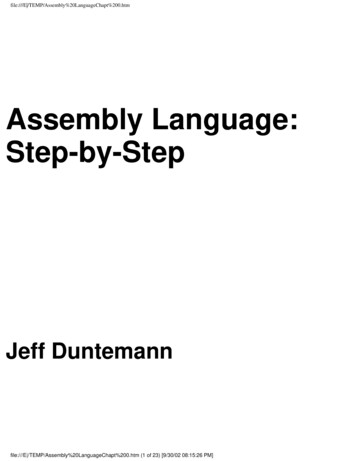
Transcription
file:///E /TEMP/Assembly%20LanguageChapt%200.htmAssembly Language:Step-by-StepJeff Duntemannfile:///E /TEMP/Assembly%20LanguageChapt%200.htm (1 of 23) [9/30/02 08:15:26 PM]
file:///E /TEMP/Assembly%20LanguageChapt%200.htmJohn Wiley & Sons, Inc.New York Chichester Brisbane Toronto SingaporeThis publication is designed to provide accurate and authoritative information in regard tothe subject matter covered. It is sold with the understanding that the publisher is notengaged in rendering legal, accounting, or other profes-sional service. If legal advice orother expert assistance is required, the services of a competent professional person shouldbe sought. FROM A DECLARATION OF PRINCIPLES JOINTLY ADOPTED BY ACOMMITTEE OF THE AMERICAN BAR ASSOCIATION AND A COMMITTEE OFPUBLISHERS.Copyright 1992 by John Wiley & Sons, Inc.All rights reserved. Published simultaneously in CanadaReproduction or translation of any part of this work beyond that permitted by section 107or 108 of the 1976 United States Copyright Act without the written permission of thecopyright owner is unlawful. Requests for permission or further information should beaddressed to the Permissions Department, John Wiley & Sons, Inc.file:///E /TEMP/Assembly%20LanguageChapt%200.htm (2 of 23) [9/30/02 08:15:27 PM]
file:///E /TEMP/Assembly%20LanguageChapt%200.htmFor Kathleen M. Duntemann, Godmother. who gave me books when all I could do was put teeth marks inIt was a good investment.Recognizing theimportance ofpreserving whathas been written, itis a policy of JohnWiley & Sons,Inc. to have booksof enduring valuepublished in theUnited Statesprinted on acidfree paper, and weexert our bestefforts to that end.Library of Congress Cataloging-in-Publication DataDuntemann, Jeff. 1952 Assembly language : step-by-step / Jeff Duntemann.p. cm. Includes index.ISBN 0-471-57814-2 (paper : alk. paper) 1. Assembler language (Computer programfile:///E /TEMP/Assembly%20LanguageChapt%200.htm (3 of 23) [9/30/02 08:15:27 PM]
file:///E /TEMP/Assembly%20LanguageChapt%200.htmlanguage) QA76.73.A8D87 1992 005.265-dc20I. Title.92-16665 CIPPrinted in the United States of America93 10 9876543Introduction:Agony in the Key of AXWhat astonishes me about learning how to program is not that it's so hard, but that it's soeasy. Am I nuts? Hardly. It's just that my curse is the curse of a perfect memory, and Iremember piano lessons. My poor mother paid 600 in 1962 for a beautiful cherrywoodspinet, and every week for two years I trucked off to Wilkins School of Music for a fivedollar lesson. It wasn't that I was a reluctant student; I love music and I genuinely wantedto master the damned thing. But after two years, the best I could do was play "Camelot"well enough to keep the dog from howling. I can honestly say that nothing I ever triedfile:///E /TEMP/Assembly%20LanguageChapt%200.htm (4 of 23) [9/30/02 08:15:27 PM]
file:///E /TEMP/Assembly%20LanguageChapt%200.htmand failed to achieve after that (including engineering school and sailboarding) wasanything close to that difficult.That's why I say: if you can play the piano, you can learn to program in assemblylanguage. Even if you can't play the piano, I hold that you can learn to program inassembly language, if: You've ever done your own long-form taxes You've earned a degree in medicine, law, or engineering You've ever put together your kid's swing set You've ever cooked a five-course dinner for eight and gotten everything to the table,hot, at all the right timesStill, playing the piano is the acid test. There are a lot more similarities than there aredifferences. To wit:In both cases, you sit down in front of a big expensive machine with a keyboard. You tryto memorize a system of notation that seems to have originated on Mars. You press thekeys according to incomprehensible instruc-tions in stacks of books. Ultimately, you sitthere and grit your teeth while making so many mistakes your self-confidence dribblesout of your pores and disappears into the carpet padding. In many cases, it gets so badthat you hurl the books against the wall and stomp off to play Yahtzee with your littlebrother.The differences are fewer: mistakes committed while learning assembly language won'tmake the dog howl. And, more crucially, what takes years of agony in front of a pianocan be done in a couple of months in front of your average PC.Furthermore, I'll do my best to help.That's what this book is for: to get you started as an assembly-language programmer froma dead stop. I'll assume that you know how to run your machine. That is, I won't gothrough all that nonsense about flipping the big red switch and inserting a disk in a driveand holding down the Ctrl key while pressing the C key. Van Wolverton can teach you allthat stuff.On the other hand, I won't assume that you know anything about pro-gramming, nor verymuch about what happens inside the box itself. That means the first few sections will bethe kind of necessary groundwork that will start you nodding off if you've been through italready. There's no helping that. Skip to Section 3 or so if you get bored.I also have to come clean here and admit that this book is not intended to be a completetutorial on assembly language, or even close to it. What I want to do is get you familiarenough with the jargon and the assumptions of assembly language so that you can pick upyour typical "introduction" to assembly language and not get lost by page 6. I specificallyrecommend Tom Swan's excellent book, Mastering Turbo Assembler, which will takefile:///E /TEMP/Assembly%20LanguageChapt%200.htm (5 of 23) [9/30/02 08:15:27 PM]
file:///E /TEMP/Assembly%20LanguageChapt%200.htmyou the rest of the way if you use Borland's assembler. A comparable book devoted toMicrosoft's MASM has not yet been written, but even if you use MASM, Tom's book willstill be valuable and you'll learn a lot from it. Mastering Turbo Assembler canoccasionally be found in bookstores, or you can order it by mail through PCTECHNIQUES Bookstream.Assembly language is almost certainly the most difficult kind of computer programming,but keep in mind that we're speaking in relative terms here. Five pushups are harder to dothan five jumping jacks—but compared to running the Marathon, both amount to almostnothing. Assembly language is more difficult to learn than Pascal, but compared toraising your average American child from birth to five years, it's a cakewalk.So don't let the mystique get you. Assembly-language programmers feel pretty smugabout what they've learned to do, but in our workaday lives we are forced to learn and dothings that put even assembly language to shame. If you're willing to set aside a couplemonths' worth of loose moments, you can pick it up too. Give it a shot. Your neighborswill thank you.And so will the dog.—-Jeff Duntemann Scottsdale, AZ March 1992A Note to People WhoHave Never ProgrammedBeforeMore than anyone else, this book was written for you. Starting with assembly languagewould not be most people's first choice in a computer language, but it's been done; it canbe done, and it can be done with less agony than you might think. Still, it's a novel aimfor a computer book, and I'd like you to do a little quality control for me and tell me howI'm doing.While you're going through this book, ask yourself once in a while: is it working? And iffile:///E /TEMP/Assembly%20LanguageChapt%200.htm (6 of 23) [9/30/02 08:15:27 PM]
file:///E /TEMP/Assembly%20LanguageChapt%200.htmnot, why not?If I lose you somewhere in the discussion, jot a note in the margin. Tell me where I lostyou. If possible, tell me why. (And saying, "I just don't get it" is perfectly acceptable, aslong as you tell me where in the book you were when you started not to get it.)As with all my books, I hope to keep this one in print well into the 21st century, revisingit as need be to hone my technique and follow the technol-ogy. Telling me how the bookworks or doesn't work will, in time, help me make a better book.Write to me at:Jeff Duntemann PC TECHNIQUES Magazine7721 E. Gray Road #204Scottsdale, A2 85260I can't reply individually to all letters, (not if I ever intend to get another book written!)but you'll have my eternal gratitude nonetheless.How to Get the Mostfrom this BookBy design, this is a serial-access book. I wrote it to be read like one of thosebad/wonderful novels, starting at page one and moving right along to the end. Virtuallyall of the chapters depend on the chapters that came before them, and if you read achapter here and a chapter there, there's some danger that the whole thing won't gel.If you're already familiar with programming, you could conceivably skip Chapters 0,1,and 2. But why not assume there's a hole or two in parts of your experience and a littlerust on the rest? Skill is not simply knowledge, but the resonance that comes of seeinghow different facets of knowledge reinforce one another.Do it all. Get the big picture. (Keep in mind that I've hidden some funny stories inthere as bait!)file:///E /TEMP/Assembly%20LanguageChapt%200.htm (7 of 23) [9/30/02 08:15:27 PM]
file:///E ter 0 Another Pleasant Valley SaturdayUnderstanding What Computers Really Do0.1 It's All in the Plan0.2 Had This Been the Real Thing.0.3 Do Not Pass GO255Chapter 1 Alien BasesGetting Your Arms around Binary and Hexadecimal131. 1 The Return of the New Math Monster1.2 Counting in Martian1.3 Octal: How the Grinch Stole 8 and 91.4 Hexadecimal: Solving the Digit Shortage1.5 From Hex to Decimal and From Decimal to Hex1.6 Arithmetic in Hex1.7 Binary1.8 Hexadecimal as Shorthand for Binary14Chapter 2 Lifting The HoodDiscovering What Computers Actually Are412.1 RAXie, We Hardly Knew Ye.2.2 Switches, Transistors, and Memory2.3 The Shop Foreman and the Assembly Line2.4 The Box that Follows a Plan4243141922252934385358Chapter 3 The Right To Assemble63The Process of Making Assembly-Language Programs3.1 Nude with Bruises and Other Perplexities3.2 DOS and DOS Files3.3 Compilers and Assemblers3.4 The Assembly-Language Development Processfile:///E /TEMP/Assembly%20LanguageChapt%200.htm (8 of 23) [9/30/02 08:15:27 PM]64657179
file:///E /TEMP/Assembly%20LanguageChapt%200.htm3.5 DEBUG and How to Use It89Chapter 4 Learning and Using JedA Programming Environment for Assembly Language4.1 A Place to Stand with Access to Tools4.2 JED's Place to Stand4.3 Using JED's Tools4.4 JED's Editor in Detail99100101104116Chapters An Uneasy Alliance131The 8086/8088 CPU and Its Segmented Memory System5.1 Through a Glass, with Blinders1325.2 "They're Diggin' It up in Choonks!"1355.3 Registers and Memory Addresses141Chapter 6 Following Your InstructionsMeeting Machine Instructions Up Close and Personal6.1 Assembling and Executing Machine Instructionswith DEBUG6.2 Machine Instructions and Their Operands6.3 Assembly-Language References6.4 An Assembly-Language Reference for Beginners6.5 Rally 'Round the Flags, Boys!6.6 Using Type OverridesChapter7 Our Object All SublimeCreating Programs That Work7.1 The Bones of an Assembly-Language Program7.2 First In, First Out via the Stack7.3 Using DOS Services through INT7.4 Summary: EAT.ASM on the Dissection Tablefile:///E /TEMP/Assembly%20LanguageChapt%200.htm (9 of 23) [9/30/02 08:15:27 PM]153154157167168173178181182193200209
file:///E /TEMP/Assembly%20LanguageChapt%200.htmChapter8 Dividing and ConqueringUsing Procedures and Macros to Battle Complexity8.1 Programming in Martian8.2 Boxes Within Boxes8.3 Using BIOS Services8.4 Building External Libraries of Procedures8.5 Creating and Using Macros215Chapter 9 Bits, Flags, Branches, and TablesEasing into Mainstream Assembly Programming2619.1 Bits is Bits (and Bytes is Bits)9.2 Shifting Bits9.3 Flags, Tests, and Branches9.4 Assembler Odds'n'Ends262Chapter 10 Stringing Them UpThose Amazing String Instructions31110.1 The Notion of an Assembly-Language String10.2 REP STOSW: The Software Machine Gun10.3 The Semiautomatic Weapon: STOSW without REP10.4 Storing Data to Discontinuous Strings312314318327216216224235248269276290 Chapter 11 O Brave New World!339The Complications of Assembly-Language Programming in the '90s11.1 A Short History of the CPU Wars11.2 Opening Up the Far Horizon11.3 Using the "New" Instructions in the 8028611.4 Moving to 32 Bits with the 386 and 48611.5 Additional 386/486 Instructions11.6 Detecting Which CPU Your Code Is Running On346352357360Chapter 12 Conclusion369file:///E /TEMP/Assembly%20LanguageChapt%200.htm (10 of 23) [9/30/02 08:15:27 PM]341342
file:///E /TEMP/Assembly%20LanguageChapt%200.htmNot the End, but Only the BeginningAppendix A Partial 8086/8088 Instruction Set Reference 373Appendix B The Extended ASCII Code and Symbol Set 421Appendix C Segment Register Assumptions425Index427Another Pleasant ValleySaturdayUnderstanding What Computers Really Do0.1 It's All in the Plan 10.2 Had This Been the Real Thing. 50.3 Do Not Pass GO 5file:///E /TEMP/Assembly%20LanguageChapt%200.htm (11 of 23) [9/30/02 08:15:27 PM]
file:///E /TEMP/Assembly%20LanguageChapt%200.htm0.1 It's All in the PlanQuick, get the kids up, it's past 7. Nicky's got Little League at 9 and Dione's got ballet at10. Mike, give Max his heartworm pill! (We're out of them, ma, remember?) Your fatherpicked a great weekend to go fishing. .here, let me give you ten bucks and go get morepills at the vet's.my God, that's right, Hank needed gas money and left me broke. There'sa teller machine over by K-Mart, and I if I go there I can take that stupid toilet seat backand get the right one.I guess I'd better make a list.It's another Pleasant Valley Saturday, and thirty-odd million suburban home-makers sitdown with a pencil and pad at the kitchen table to try and make sense of a morning thatwould kill and pickle any lesser being. In her mind, she thinks of the dependencies andtraces the route:Drop Nicky at Rand Park, go back to Dempster and it's about ten minutes to Golf MillMall. Do I have gas? I'd better check first—if not, stop at Del's Shell or I won't make it toMilwaukee Avenue. Bleed the teller machine at Golf Mill, then cross the parking lot to KMart to return the toilet seat that Hank bought last weekend without checking what shapeit was. Gotta remember to throw the toilet seat in back of the van—write that at the top ofthe list.By then it'll be half past, maybe later. Ballet is all the way down Greenwood in ParkRidge. No left turn from Milwaukee—but there's the sneak path around behind the Mall. Ihave to remember not to turn right onto Milwaukee like I always do—jot that down.While I'm in Park Ridge I can check and see if Hank's new glasses are in—should call butthey won't even be open until 9:30. Oh, and groceries—can do that while Dione dances.On the way back I can cut over to Oakton and get the dog's pills.In about ninety seconds flat the list is complete: Throw toilet seat in vanfile:///E /TEMP/Assembly%20LanguageChapt%200.htm (12 of 23) [9/30/02 08:15:27 PM]
file:///E /TEMP/Assembly%20LanguageChapt%200.htm Check gas—if empty, stop at Del's Shell Drop Nicky at Rand Park Stop at Golf Mill teller machine Return toilet seat at K-Mart Drop Dione at ballet (remember back path to Greenwood) See if Hank's glasses are at Pearle Vision—if they are, make double sure theyremembered the extra scratch coating Get groceries at Jewel Pick up Dione Stop at vet's for heartworm pills Drop off groceries at home If it's time, pick up Nicky. If not, collapse for a few minutes, then pick up Nicky. Collapse!In what we often call a "laundry list" (whether it involves laundry or not) is the perfectmetaphor for a computer program. Without realizing it, our intrepid homemaker haswritten herself a computer program, and then set out (acting as the computer) to execute itcompletely before noon.Computer programming is nothing more than this: You the programmer write a list ofsteps and tests. The computer then performs each step and test in sequence. When the listof steps has been executed, the computer stops.A computer program is a list of steps and tests, nothing more.Steps and TestsThink for a moment about what I call a "test" in the laundry list shown above. A test isthe sort of either/or decision we make dozens or hundreds of times on even the mostplacid of days, sometimes nearly without thinking about it.Our homemaker performed a test when she jumped into the van to get started on heradventure. She looked at the gas gauge. The gas gauge would tell her one of two things:1) She has enough gas, or 2) no, she doesn't. If she has enough gas, she takes a right andheads for Rand Park. If she doesn't have enough gas, she takes a left down to the cornerand fills the tank at Del's Shell. (Del takes credit cards.) Then, with a full tank, shecontinues the program by taking a U-turn and heading for Rand Park.In the abstract, a test consists of those two parts: First you take a look at something that can go one of two ways.file:///E /TEMP/Assembly%20LanguageChapt%200.htm (13 of 23) [9/30/02 08:15:27 PM]
file:///E /TEMP/Assembly%20LanguageChapt%200.htm Then you do one of two things, depending on what you saw when you took a look.Toward the end of the program, our homemaker got home, took the groceries out of thevan, and took a look at the clock. If it wasn't time to get Nicky back from Little League,she has a moment to collapse on the couch in a nearly empty house. If it is time to getNicky, there's no rest for the ragged: She sprints for the van and heads back to Rand Park.(Any guesses as to whether she really gets to collapse when the program is complete?)More than Two Ways?You might object that many or most tests involve more than two alternatives.Except for totally impulsive behavior, every human decision comes down to the choice ofone of two alternatives.What you have to do is look a little more closely at what goes through your mind whenyou make decisions. The next time you buzz down to Moo Foo Goo for fast Chinese,observe yourself while you're poring over the menu. The choice might seem, at first, to beof one item out of 26 Cantonese main courses. Not so—the choice, in fact, is betweenchoosing one item and not choosing that one item. Your eyes rest on Cashew Chicken.Naw, too bland. That was a test. You slide down to the next item. Chicken with BlackMushroom. Hmmm, no, had that last week. That was another test. Next item: Kung PaoChicken. Yeah, that's it! That was a third test.The choice was not among Cashew Chicken, Chicken with Black Mush-rooms, or KungPao Chicken. Each dish had its moment, poised before the critical eye of your mind, andyou turned thumbs up or thumbs down on it, individually. Eventually, one dish won, butit won in that same game of "To eat or Not to eat."Many of life's most complicated decisions come about because 99% of us are not nudists.You've been there-. You're standing in the clothes closet in your underwear, flippingthrough your rack of pants. The tests come thick and fast. This one? No. This one? No.This one? No. This one? Yeah. You pick a pair of blue pants, say. (It's a Monday, afterall, and blue would seem an appropriate color.) Then you stumble over to your sockdrawer and take a look. Whoops, no blue socks. That was a test. So you stumble back tothe clothes closet, hang your blue pants back on the pants rack, and start over. This one?No. This one? No. This one? Yeah. This time it's brown pants, and you toss them overyour arm and head back to the sock drawer to take another look. Nertz, out of brownsocks, too. So it's back to the clothes closet.What you might consider a single decision, or perhaps two decisions inextricably tangled(like picking pants and socks of the same color, given stock on hand) is actually a seriesfile:///E /TEMP/Assembly%20LanguageChapt%200.htm (14 of 23) [9/30/02 08:15:27 PM]
file:///E /TEMP/Assembly%20LanguageChapt%200.htmof small decisions, always binary in nature: Pick 'em or don't pick'em. Find 'em or don'tfind 'em. The Monday morning episode in the clothes closet is a good analog of aprogramming structure called a loop. You keep doing a series of things until you get itright, and then you stop. (Assuming you're not the kind of guy who wears blue socks withbrown pants.) But whether you get everything right always comes down to a sequence ofsimple, either/or decisions.Computers Think Like UsI can almost hear what you're thinking: "Sure, it's a computer book, and he's trying to getme to think like a computer." Not at all. Computers think like us.We designed them; how else could they think? No, what I'm trying to do is get you totake a long hard look at how you think. We run on automatic for so much of our lives thatwe literally do most of our thinking without really thinking about it.The very best model for the logic of a computer program is the very same logic we use toplan and manage our daily affairs. No matter what we do, it comes down to a matter ofconfronting two alternatives and picking one. What we might think of as a single largeand complicated decision is nothing more than a messy tangle of many smaller decisions.The skill of looking at a complex decision and seeing all the little decisions in its tummywill serve you well in learning how to program. Observe yourself the next time you haveto decide something. Count up the little decisions that make up the big one. You'll besurprised.And, surprise! You'll be a programmer.0.2 Had This Been the Real Thing.Do not be alarmed. What you have just experienced was a metaphor. It was not the realthing. (The real thing comes later.)I'll be using metaphors a lot in this book. A metaphor is a loose comparison drawnbetween something familiar (like a Saturday morning laundry list) and somethingunfamiliar (like a computer program.) The idea is to anchor the unfamiliar in the terms ofthe familiar, so that when I begin tossing facts at you you'll have someplace comfortableto lay them down. The facts don't start until Chapter 1. (That's why I call this Chapter 0:Metaphors only, please.)The most important thing for you to do right now is keep an open mind. If you know afile:///E /TEMP/Assembly%20LanguageChapt%200.htm (15 of 23) [9/30/02 08:15:27 PM]
file:///E /TEMP/Assembly%20LanguageChapt%200.htmlittle bit about computers or programming, don't pick nits. Yes, there are importantdifferences between a homemaker following a scribbled laundry list and a computerexecuting a program. I'll mention those differences all in good time.For now, it's still Chapter 0. Take these initial metaphors on their own terms. Later on,they'll help a lot.0.3 Do Not Pass GO"There's a reason bored and board are homonyms," said my best friend Art one evening,as we sat (two super-sophisticated twelve-year-olds) playing some game in his basement.(He may have been unhappy because he was losing.) Was it Mille Bornes? Or Stratego?Or Monopoly? Or something else entirely? I confess I don't remember. I simply recallhopping some little piece of plastic shaped like a pregnant bowling pin up and down aseries of colored squares that told me to do dumb things like go back two spaces or put 100in the pot or nuke Outer Mongolia.Outer Mongolia notwithstanding, there are strong parallels to be drawn between thatpeculiar American obsession, the board game, and assembly-language programming.First of all, everything we said before still holds: Board games, by and large, consist of aprogression of steps and tests. In some games, like Trivial Pursuit, every step on the boardis a test: To see if you can answer, or not answer, a question on a card. In other boardgames, each little square on the board contains some sort of instruction: Lose One Turn;Go Back Two Squares; Take a Card from Community Chest; and, of course, Go to Jail.Certain board games made for some lively arguments between Art and me (it was that orbe bored, as it were) concerning what it meant to Go Forward or Backward Five Steps. Itseemed to me that you should count the square you were already on. Art, traditionalistalways, thought you should start counting with the first step in the direction you had togo. This made a difference in the game, of course. (I conveniently forgot to press mypoint when doing so would land me on something like Park Place with fifteen of Art'shotels on it.)The Game of Big BuxTo avoid getting in serious trouble, I have invented my own board game to continue withthis particular metaphor. In the sense that art mirrors life, the Game of Big Bux mirrorslife in Silicon Valley, where money seems to be spontaneously created (generally infile:///E /TEMP/Assembly%20LanguageChapt%200.htm (16 of 23) [9/30/02 08:15:27 PM]
file:///E /TEMP/Assembly%20LanguageChapt%200.htmsomebody else's pocket) and the three big Money Black Holes are fast cars, Californiareal estate, and messy divorces.A portion of the Big Bux game board is shown on the following page. The line ofrectangles on the left side of the page continues all the way around the board. In themiddle of the board are cubbyholes to store your play money and game pieces; stacks ofcards to be read occasionally; and short "detours" with names like Messy Divorce andStart a Business, which are brief sequences of the same sort of action rectangles as thoseforming the path around the edge of the board.Unlike many board games, you don't throw dice to determine how many steps around theboard you take. Big Bux requires that you move one step forward on each turn, unless thesquare you land on instructs you to move forward or backward or go somewhere else, likethrough a detour. This makes for a considerably less random game. In fact, Big Bux is apretty deterministic game, meaning that whether you win or lose is far less important thanjust going through the ringer and coming out the other side. (Again, this mirrors SiliconValley, where you come out either bankrupt or ready to flee to Peoria and open ahardware store. That other kind of hardware.)There is some math involved. You start out with one house, a cheap car, and 50,000 incash. You can buy CDs at a given interest rate, payable each time you make it oncearound the board. You can invest in stocks and other securities whose value is determinedby a changeable index in economic indicators, which fluctuates based on cards chosenfrom the stack calledFickle Finger of Fate. You can sell cars on a secondary market, buy and sell houses, andwheel and deal with the other players. Each time you make it once around the board youhave to recalculate your net worth. All of this involves some addition, subtraction,multiplication, and division, but there's no math more complex than compound interest.Most of Big Bux involves nothing more than taking a step and following the instructionsat each step. Is this starting to sound familiar?Playing Big BuxAt one corner of the Big Bux board is the legend Move In, since that's how people startlife in California—no one is actually born there. Once you're moved in, you beginworking your way around the board, square by square, following the instructions in thesquares.Some of the squares simply tell you to do something, like Buy condo in Palo Alto for 5%down. Many of the squares involve a test of some kind. For example, one square reads: Isyour job boring? (Prosperity Index 0.3 but less than 4.0) If not, jump ahead 3 squares.file:///E /TEMP/Assembly%20LanguageChapt%200.htm (17 of 23) [9/30/02 08:15:27 PM]
file:///E /TEMP/Assembly%20LanguageChapt%200.htmThe test is actually to see if the Prosperity Index has a value between 0.3 and 4.0. Anyvalue outside those bounds (i.e., runaway prosperity or Four Horsemen class recession)are defined as Interesting Times, and cause a jump ahead by three squares.You always move one step forward at each turn, unless the square you land on directs youto do something else, like jump forward three squares or jump back five squares.The notion of taking a detour is an interesting one. Two detours are shown in the portionof the board I've provided. Taking a detour means leaving the main run around the edgeof the game board and stepping through a series of squares elsewhere on the board. Thedetours involve some specific process; i.e., starting a business or getting divorced.You can work through a detour, step by step, until you hit the bottom. At that point yousimply pick up your journey around the board right where you left it. You may also findthat one of the squares in the detour instructs you to go back to where you came from.Depending on the logic of the game (and your luck and finances) you may completely runthrough a detour, or get thrown out somewhere in the middle.Also note that you can take a detour from within a detour. If you detour through Start aBusiness and your business goes bankrupt, you leave Start a Business temporarily anddetour through Messy Divorce. Once you leave Messy Divorce you return to where youleft Start a Business. Ultimately, you also leave Start a Business and return to wherever itwas you were when you took the detour.The same detour (for example, Start a Business) can be taken from any of severaldifferent places along the game board.file:///E /TEMP/Assembly%20LanguageChapt%200.htm (18 of 23) [9/30/02 08:15:27 PM]
file:///E /TEMP/Assembly%20LanguageChapt%200.htmAssembly Language Programming as a Board GameNow that you're thinking in terms of board games, take a look at Figure 0.2. What I'vedrawn is actually a fair approximation of assembly language as it was used on some ofour simpler microprocessors about ten or twelve years ago. The PROGRAMINSTRUCTIONS column is the main path around the edge of the board, of which only aportion can be shown here. This is the assembly language computer program, the actualseries of steps and tests that, when executed, causes the computer to do something useful.Setting up this series of program instructions is what programming in assembly languageactually is.Everything else is odds and ends i
That's why I say: if you can play the piano, you can learn to program in assembly language. Even if you can't play the piano, I hold that you can learn to program in assembly language, if: You've ever done your own long-form taxes You've earned a degree in medicine, law, or en
